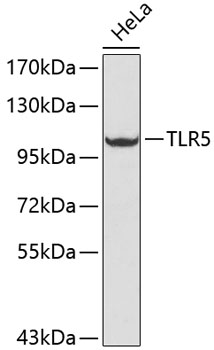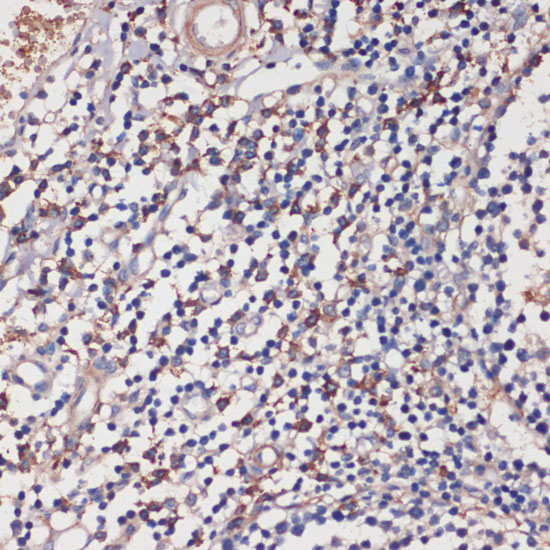Immunology Antibodies 2
Anti-TLR5 Antibody (CAB1721)
- SKU:
- CAB1721
- Product Type:
- Antibody
- Reactivity:
- Human
- Host Species:
- Rabbit
- Isotype:
- IgG
- Antibody Type:
- Polyclonal Antibody
- Research Area:
- Immunology
Description
| Antibody Name: | Anti-TLR5 Antibody |
| Antibody SKU: | CAB1721 |
| Antibody Size: | 20uL, 50uL, 100uL |
| Application: | WB IHC |
| Reactivity: | Human |
| Host Species: | Rabbit |
| Immunogen: | Recombinant fusion protein containing a sequence corresponding to amino acids 714-858 of human TLR5 (NP_003259.2). |
| Application: | WB IHC |
| Recommended Dilution: | WB 1:500 - 1:2000 IHC 1:50 - 1:200 |
| Reactivity: | Human |
| Positive Samples: | HeLa |
| Immunogen: | Recombinant fusion protein containing a sequence corresponding to amino acids 714-858 of human TLR5 (NP_003259.2). |
| Purification Method: | Affinity purification |
| Storage Buffer: | Store at -20'C. Avoid freeze / thaw cycles. Buffer: PBS with 0.02% sodium azide, 50% glycerol, pH7.3. |
| Isotype: | IgG |
| Sequence: | HLDT QYSD QNRF NLCF EERD FVPG ENRI ANIQ DAIW NSRK IVCL VSRH FLRD GWCL EAFS YAQG RCLS DLNS ALIM VVVG SLSQ YQLM KHQS IRGF VQKQ QYLR WPED LQDV GWFL HKLS QQIL KKEK EKKK DNNI PLQT VATI S |
| Gene ID: | 7100 |
| Uniprot: | O60602 |
| Cellular Location: | Membrane, Single-pass type I membrane protein |
| Calculated MW: | 97kDa |
| Observed MW: | 100kDa |
| Synonyms: | MELIOS, SLE1, SLEB1, TIL3, TLR5 |
| Background: | This gene encodes a member of the toll-like receptor (TLR) family, which plays a fundamental role in pathogen recognition and activation of innate immune responses. These receptors recognize distinct pathogen-associated molecular patterns that are expressed on infectious agents. The protein encoded by this gene recognizes bacterial flagellin, the principal component of bacterial flagella and a virulence factor. The activation of this receptor mobilizes the nuclear factor NF-kappaB, which in turn activates a host of inflammatory-related target genes. Mutations in this gene have been associated with both resistance and susceptibility to systemic lupus erythematosus, and susceptibility to Legionnaire disease. |
| UniProt Protein Function: | TLR5: Participates in the innate immune response to microbial agents. Mediates detection of bacterial flagellins. Acts via MYD88 and TRAF6, leading to NF-kappa-B activation, cytokine secretion and the inflammatory response. Genetic variation in TLR5 is associated with resistance to systemic lupus erythematosus type 1 (SLEB1). Systemic lupus erythematosus (SLE) is a chronic autoimmune disease with a complex genetic basis. SLE is an inflammatory, and often febrile multisystemic disorder of connective tissue characterized principally by involvement of the skin, joints, kidneys, and serosal membranes. It is thought to represent a failure of the regulatory mechanisms of the autoimmune system. Belongs to the Toll-like receptor family. |
| UniProt Protein Details: | Protein type:Receptor, misc.; Membrane protein, integral Chromosomal Location of Human Ortholog: 1q41-q42 Cellular Component: integral to membrane; plasma membrane Molecular Function:transmembrane receptor activity; interleukin-1 receptor binding Biological Process: MyD88-dependent toll-like receptor signaling pathway; toll-like receptor 5 signaling pathway; positive regulation of interleukin-8 production; regulation of cytokine secretion; positive regulation of nitric oxide biosynthetic process; defense response to bacterium; male gonad development; toll-like receptor signaling pathway; innate immune response; inflammatory response; positive regulation of toll-like receptor signaling pathway; toll-like receptor 10 signaling pathway Disease: Legionnaire Disease, Susceptibility To; Systemic Lupus Erythematosus, Susceptibility To, 1; Melioidosis, Susceptibility To |
| NCBI Summary: | This gene encodes a member of the toll-like receptor (TLR) family, which plays a fundamental role in pathogen recognition and activation of innate immune responses. These receptors recognize distinct pathogen-associated molecular patterns that are expressed on infectious agents. The protein encoded by this gene recognizes bacterial flagellin, the principal component of bacterial flagella and a virulence factor. The activation of this receptor mobilizes the nuclear factor NF-kappaB, which in turn activates a host of inflammatory-related target genes. Mutations in this gene have been associated with both resistance and susceptibility to systemic lupus erythematosus, and susceptibility to Legionnaire disease.[provided by RefSeq, Dec 2009] |
| UniProt Code: | O60602 |
| NCBI GenInfo Identifier: | 215274239 |
| NCBI Gene ID: | 7100 |
| NCBI Accession: | O60602.4 |
| UniProt Secondary Accession: | O60602,O15456, Q32MI2, Q32MI3, B1AZ05, B3Y633, B9VJ63 D1CS80, D3DTB8, |
| UniProt Related Accession: | O60602 |
| Molecular Weight: | 97,834 Da |
| NCBI Full Name: | Toll-like receptor 5 |
| NCBI Synonym Full Names: | toll-like receptor 5 |
| NCBI Official Symbol: | TLR5 |
| NCBI Official Synonym Symbols: | SLE1; TIL3; SLEB1; MELIOS |
| NCBI Protein Information: | toll-like receptor 5 |
| UniProt Protein Name: | Toll-like receptor 5 |
| UniProt Synonym Protein Names: | Toll/interleukin-1 receptor-like protein 3 |
| Protein Family: | Toll-like receptor |
| UniProt Gene Name: | TLR5 |
| UniProt Entry Name: | TLR5_HUMAN |








